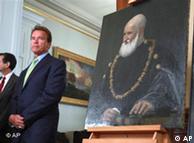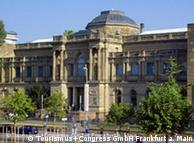News:
Museums are morally obligated to return Nazi-looted art, says expert
Frankfurt's Staedel Museum has investigated its role in the Third Reich. Its art history expert and provenance researcher Nicole Roth told DW how she goes about examining the museum's collection for stolen pieces.
In 1999, Germany's Representative of the Federal Government for Culture, Michael Naumann, sent a letter to the directors of all the museums in the country, requesting that they determine and reveal the origin of any works acquired between 1933 and 1945. Shortly before Naumann's appeal, the German federal government and state and municipal leaders had pledged to return to the rightful owners any works of art dispossessed by the Nazis. In order to make that happen, many museums hired provenance researchers, experts specially trained in critically examining the history behind works of art.
One of them was the Staedel Museum in Frankfurt. With a collection of some 2,700 paintings, 600 sculptures and more than 100,000 drawings and prints, the museum covers seven hundred years of art history, from the 14th century to the present. Highlights include works by Cranach the Elder, Botticelli, Rembrandt, Monet, Picasso, Bacon, Richter and Kippenberger.
Nicole Roth, a provenance researcher at the Staedel Museum, explained how her job works.
Deutsche Welle: Why is the restitution of art looted by the moving at such a slow pace?
Nicole Roth: I prefer to view it on a case by case basis. The circumstances surrounding an individual painting are different to those of artwork in general. And museums which have provenance researchers are better equipped to investigate individual cases more quickly.
Can you give an example of a case where a piece of art was returned quickly and without any hold-ups?
It can happen very quickly if there are inconsistencies in the inventory register. A Jewish surname is obviously a reason to take a closer look, or if I notice a suspicious sale price or a relevant previous owner turns up - I would consdier it worth doing further research.
Can you give us a concrete example from your working life?
As a concrete example I can name the Paul Stern collection, which was based in Frankfurt. I became curious when I recognized the name in the inventory register. So I did research in all the closest archives - in our own archive, in the city archive and in the Wiesbaden Central State Archive. And I found out that I might be dealing with cultural assets that had been dispossessed as part of the Nazis' persecution policy.

Bildunterschrift: Großansicht des Bildes mit der Bildunterschrift: In April 2009, Schwarzenegger oversaw the return of two Renaissance paintings to the Oppenheimer family
That's how you find the works, the next step is to track down the owners' heirs. We might do that by posting the pieces in question on the Lost Art Register website -- a databank for art looted by the Nazis -- in order to make people aware that we are looking for the heirs.
How important is the Internet for your work?
Very, very important. I can hardly imagine how I would have done the research 25 or 30 years ago, when this vast amount of Internet data simply wasn't available.
It's also important to mention the help provenance researchers get from one another. For example, I might email colleagues from other institutions to ask if they've heard of a particular art dealer, or whether they know about this or that auction. It would take a lot more time to have to call each colleague individually. The Internet is really a huge plus.
What kind of limitations do you have to deal with? What is the current legal situation?
The deadlines [for returning the works] have all expired. Essentially, our aim is to uphold the Washington Principles, which determine how to deal with the artworks.
Which principles are those?
Museums are under a moral obligation to return Nazi-era looted art to its rightful owners or their heirs.
[Editors' note: The Washington Principles were signed by 44 nations at a conference in Washington, DC in 1998 and stipulate the restitution of Nazi-era cultural assets. Click on the link below to read the Washington Principles.]
Why is it still problematic for some museums to work through their Nazi-related past?
I think the problem has generally been recognized and most museums are interested in finding a solution. In the beginning it was difficult because provenance research was very time consuming.
But since the advent of the Post for Provenance Research and Investigation, which supports museums and helps finance researchers across Germany, more museums are introducing such posts.
[Editors' note: The Post for Provenance Research and Investigation, founded in 2007, in funded by the German federal government and works closely together with Germany's Lost Art Internet Database.]
Interview: Conny Paul (kjb)
Editor: Tamsin Walker



